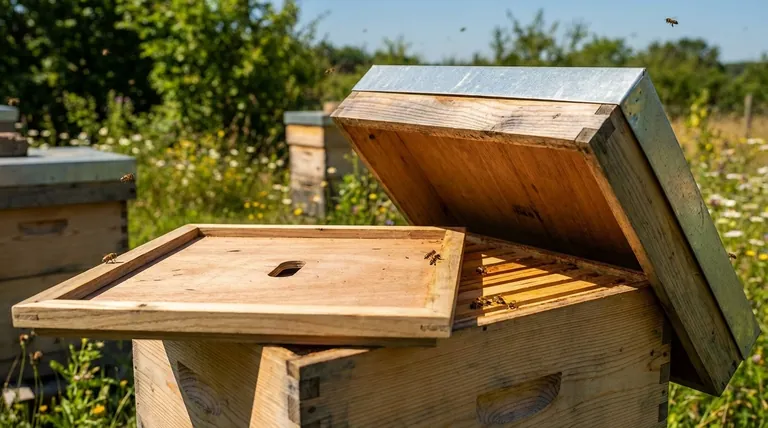To be direct, the two top pieces of a standard beehive are the inner cover and the outer top cover, often called a telescoping cover. These two components work together as a system to protect the hive from the elements, provide crucial insulation and ventilation, and make hive inspections more manageable for the beekeeper.
The core principle to understand is that the hive's "roof" is a two-part system for a reason. The outer cover handles the weather, while the inner cover manages the hive's internal environment and the beekeeper's access.

The Dual-Cover System Explained
A common point of confusion for new beekeepers is why two separate covers are necessary. Thinking of them as a single, integrated system clarifies their distinct and complementary roles in maintaining a healthy colony.
The Outer Cover: The First Line of Defense
The outer top cover is the hive's primary shield against the environment. It is designed to be completely waterproof, protecting the colony from rain and snow.
Most modern hives use a telescoping cover, which has sides that extend down over the top hive box. This creates a protective lip that prevents water from seeping into the hive's seams. Many are also capped with metal for increased durability.
The Inner Cover: The Hive's Ceiling
The inner cover sits directly on top of the uppermost hive box, beneath the outer cover. Its purpose is not to stop weather but to manage the internal environment of the hive.
This piece creates a layer of dead air space between it and the outer cover, providing critical insulation against both heat and cold. It also prevents the bees from gluing the outer cover to the hive body with propolis and brace comb, which would make inspections nearly impossible.
Key Functions of the Inner Cover
While the outer cover's function is obvious, the inner cover is a more nuanced and essential piece of equipment for both the bees and the beekeeper.
Creating Crucial Air Space
The gap between the inner and outer covers acts as a buffer zone. This layer of trapped air helps insulate the hive, keeping it warmer in the winter and cooler in the summer, reducing stress on the colony.
Facilitating Ventilation
Most inner covers have a small, notched opening on one side and a larger hole in the center. The notch can be positioned to create an upper entrance or ventilation port, which is vital for allowing excess moisture to escape, especially during winter.
Aiding in Hive Management
The inner cover is an indispensable tool during inspections. When you remove the outer cover, the inner cover keeps the bees contained, preventing a rush of agitated bees from boiling out of the hive. The central hole is also perfectly designed to accommodate certain types of hive-top feeders.
Common Pitfalls to Avoid
Understanding the system allows you to avoid common mistakes that can harm the colony or create unnecessary work.
Forgetting the Inner Cover
Operating a hive without an inner cover is a frequent error. Bees will inevitably build comb and seal the gap between the top frames and the outer cover, making it incredibly difficult to remove the lid without damaging the colony and angering the bees.
Improper Ventilation
Failing to use the inner cover's ventilation features correctly can lead to problems. In winter, trapping too much moisture can cause condensation to drip down on the cluster, which can be lethal. Ensure the notched rim is positioned to allow airflow when needed.
Making the Right Choice for Your Goal
Your equipment choices should align with your beekeeping objectives.
- If your primary focus is maximum protection and colony health: The standard combination of an inner cover and a metal-capped telescoping outer cover is the definitive choice for nearly all backyard and small-scale beekeepers.
- If your primary focus is mobility and efficiency in a commercial operation: Some large-scale beekeepers use simpler "migratory lids," which are flat and do not telescope, making hives easier to stack and move.
Mastering the function of these two top pieces transforms them from simple lids into essential tools for managing a thriving colony.
Summary Table:
| Component | Primary Function | Key Benefit |
|---|---|---|
| Inner Cover | Manages internal hive environment (insulation, ventilation) | Prevents propolis sealing, aids inspections, reduces bee stress |
| Outer Top Cover | Provides primary weatherproofing (rain, snow) | Telescoping design ensures complete waterproof protection |
Ensure your apiary's success with the right equipment. The proper hive covers are critical for colony health and efficient management. HONESTBEE supplies durable, high-quality inner covers and telescoping outer covers designed for the demands of commercial apiaries and beekeeping equipment distributors. Our wholesale-focused operations ensure you get the reliable gear you need to protect your investment. Contact HONESTBEE today for wholesale pricing and to discuss your specific equipment requirements.
Visual Guide

Related Products
- Inner Beehive Cover for Beekeeping Bee Hive Inner Cover
- Professional Insulated Winter Hive Wrap for Beekeeping
- Long Langstroth Style Horizontal Top Bar Hive for Wholesale
- Professional Galvanized Hive Strap with Secure Locking Buckle for Beekeeping
- Stainless Steel Beekeeping Honey Extractor Lid
People Also Ask
- What is an inner cover in a beehive and what are its features? A Key Tool for Hive Health & Management
- Why might beekeepers use an inner cover under the telescoping outer cover? Simplify Hive Management & Protect Your Colony
- What is the role of inner covers in insulated beehives? Master Moisture Control for a Healthy Colony
- What is the purpose of the inner cover in a beehive? A Key to Hive Health & Easy Management
- What is the recommended orientation for the rim of an inner cover? Master Hive Ventilation and Insulation



















